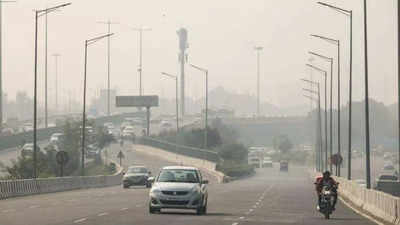- News
- City News
- gurgaon News
- Breathe! Gurugram just had year’s first good air day...
Breathe! Gurugram just had year’s first good air day...

Apart from hosting the year’s only ‘good’ air day, July has been relatively easier on the city residents. (file photo)
GURUGRAM: Nearly eight months into 2022, the city found its first spot of deep green in the pollution index. Tuesday was, finally, a ‘good’ air day — a rare occurrence for a region where atmospheric pollutants are plentiful all year round.
The last time Gurugram’s 24-hour average air quality index was ‘good’ was on October 18 last year, when the AQI was 34. On Tuesday, days of light monsoon showers and windy conditions improved the city’s AQI to 43, from 53 the day before.

Apart from hosting the year’s only ‘good’ air day, July has been relatively easier on the city residents. Data shows that the city recorded 12 ‘satisfactory’ days this July – the highest for a month in 2022. The remaining were 11 ‘moderate’ days and two ‘poor’ days.
It isn’t out of the ordinary. Monsoon months are usually the only prolonged period in a year when people in NCR can spot blue skies or breathe clean air.
July last year did not record any ‘poor’ or ‘very poor’ days — there were nine ‘moderate’ and 22 ‘satisfactory’ days that month.
This year too, Haryana State Pollution Control Board (HSPCB) officials said, scattered rainfall settled the pollutants onto the ground surface while the winds dispersed them.
According to the India Meteorological Department (IMD), the city received 3.5mm of rain in the past 24 hours and the wind speed was up to 18km/hour on Tuesday. Overall though, the city’s July rainfall was 103.9mm, a deficit of 32%.
An analysis of the data iterates that air pollution is a persistent problem in the region. Between January and July this year, Gurugram saw 95 ‘poor’ days, 76 ‘moderate’, 20 ‘very poor’ days, 15 ‘satisfactory’ days and just one ‘good’ air day.
HSPCB officials said that apart from the obvious pollutants like particulate matter (PM) and toxic gases, there was an overwhelming effect of dust in bringing down air quality, especially in the summer months.
Loose soil and high wind effect in the Indo-Gangetic plain are natural sources of dust in the region. Then there is vehicular traffic that suspends road dust, in addition to that induced by construction activities, they said.
Superficially, dust may appear to be a relatively harmless pollutant, but the particles often contain toxins from combustion sources. Doctors say exposure to dust pollution can trigger a multitude of health issues, from cough and bronchitis to asthma attacks and high blood pressure.
“The Commission for Air Quality Management in NCR and adjoining areas had issued directions last year in June specifying the use of dust suppressants in the tentative list of dust control/mitigation measures. These directions were circulated to all regional officers of NCR by HSPCB and are being monitored in the construction projects by the regional offices,” said S Narayana, member secretary, HSPCB.
He added that Haryana had not yet experimented with smog towers — which filters air with the aim to clean it — because the state was waiting for an efficacy report on the already installed towers in Delhi.
Experts say data has proven that ways to reduce air pollution in NCR have to be adopted as long term measures. “The reduction in pollution is majorly due to good rainfall that happened in the last 2-3 days, and the presence of wind also plays a vital role. Dust and pollution mitigation through forest sinks is important to control pollution. This green walling is needed against desertification, and ingress of dust and cleansing of toxic gases,” said Shubhansh Tiwari, a research associate at Amity Centre for Air Pollution Control.
According to a study by the University of Chicago’s Energy Policy Institute (EPIC) published in September last year, residents of Gurugram lose 9.9 years of their lives due to prolonged exposure to air pollution. The same report, titled the Air Quality Life Index (AQLI), pointed out that people in Haryana lose an average of 8.4 years of their life expectancy — fourth highest among any state in India.
AQI between zero and 50 is considered ‘good’, 51 and 100 ‘satisfactory’, 101 and 200 ‘moderate’, 201 and 300 ‘poor’, 301 and 400 ‘very poor’, and 401 and 500 ‘severe’.
The last time Gurugram’s 24-hour average air quality index was ‘good’ was on October 18 last year, when the AQI was 34. On Tuesday, days of light monsoon showers and windy conditions improved the city’s AQI to 43, from 53 the day before.

Apart from hosting the year’s only ‘good’ air day, July has been relatively easier on the city residents. Data shows that the city recorded 12 ‘satisfactory’ days this July – the highest for a month in 2022. The remaining were 11 ‘moderate’ days and two ‘poor’ days.
It isn’t out of the ordinary. Monsoon months are usually the only prolonged period in a year when people in NCR can spot blue skies or breathe clean air.
July last year did not record any ‘poor’ or ‘very poor’ days — there were nine ‘moderate’ and 22 ‘satisfactory’ days that month.
This year too, Haryana State Pollution Control Board (HSPCB) officials said, scattered rainfall settled the pollutants onto the ground surface while the winds dispersed them.
According to the India Meteorological Department (IMD), the city received 3.5mm of rain in the past 24 hours and the wind speed was up to 18km/hour on Tuesday. Overall though, the city’s July rainfall was 103.9mm, a deficit of 32%.
An analysis of the data iterates that air pollution is a persistent problem in the region. Between January and July this year, Gurugram saw 95 ‘poor’ days, 76 ‘moderate’, 20 ‘very poor’ days, 15 ‘satisfactory’ days and just one ‘good’ air day.
HSPCB officials said that apart from the obvious pollutants like particulate matter (PM) and toxic gases, there was an overwhelming effect of dust in bringing down air quality, especially in the summer months.
Loose soil and high wind effect in the Indo-Gangetic plain are natural sources of dust in the region. Then there is vehicular traffic that suspends road dust, in addition to that induced by construction activities, they said.
Superficially, dust may appear to be a relatively harmless pollutant, but the particles often contain toxins from combustion sources. Doctors say exposure to dust pollution can trigger a multitude of health issues, from cough and bronchitis to asthma attacks and high blood pressure.
“The Commission for Air Quality Management in NCR and adjoining areas had issued directions last year in June specifying the use of dust suppressants in the tentative list of dust control/mitigation measures. These directions were circulated to all regional officers of NCR by HSPCB and are being monitored in the construction projects by the regional offices,” said S Narayana, member secretary, HSPCB.
He added that Haryana had not yet experimented with smog towers — which filters air with the aim to clean it — because the state was waiting for an efficacy report on the already installed towers in Delhi.
Experts say data has proven that ways to reduce air pollution in NCR have to be adopted as long term measures. “The reduction in pollution is majorly due to good rainfall that happened in the last 2-3 days, and the presence of wind also plays a vital role. Dust and pollution mitigation through forest sinks is important to control pollution. This green walling is needed against desertification, and ingress of dust and cleansing of toxic gases,” said Shubhansh Tiwari, a research associate at Amity Centre for Air Pollution Control.
According to a study by the University of Chicago’s Energy Policy Institute (EPIC) published in September last year, residents of Gurugram lose 9.9 years of their lives due to prolonged exposure to air pollution. The same report, titled the Air Quality Life Index (AQLI), pointed out that people in Haryana lose an average of 8.4 years of their life expectancy — fourth highest among any state in India.
AQI between zero and 50 is considered ‘good’, 51 and 100 ‘satisfactory’, 101 and 200 ‘moderate’, 201 and 300 ‘poor’, 301 and 400 ‘very poor’, and 401 and 500 ‘severe’.
FOLLOW US ON SOCIAL MEDIA
FacebookTwitterInstagramKOO APPYOUTUBE
Start a Conversation
end of article










